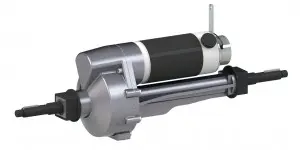How Can I Ensure the Electric Transaxle I Choose Meets Environmental Standards?
In the rapidly evolving world of electric vehicles (EVs), the electric transaxle has emerged as a critical component, combining the functions of the transmission and axle into a single unit. This integration not only enhances efficiency but also reduces weight and improves overall performance. However, with the increasing focus on sustainability and environmental protection, ensuring that your chosen electric transaxle meets environmental standards is more important than ever. This guide will walk you through the key steps and considerations to help you make an environmentally responsible choice.
Understanding Environmental Standards for Electric Transaxles
Before diving into the specifics, it’s essential to understand the broader context of environmental standards for electric transaxles. These standards are designed to minimize the environmental impact of manufacturing, operation, and disposal of the transaxle. Key areas of focus include:
Material Selection: The materials used in the transaxle should be recyclable and free from hazardous substances. This not only reduces the environmental footprint but also ensures compliance with regulations such as the Restriction of Hazardous Substances (RoHS) directive.
Energy Efficiency: The transaxle should be designed to maximize energy transfer efficiency, reducing energy loss and extending the battery life of the EV. This is crucial for reducing the overall carbon footprint of the vehicle.
Thermal Management: Effective thermal management is vital to prevent overheating, which can lead to increased energy consumption and reduced lifespan of the transaxle. This includes the use of low-viscosity fluids that enhance durability and efficiency.
Noise Pollution: Electric transaxles should be designed to operate quietly, minimizing noise pollution. This is particularly important in urban environments where noise levels can significantly impact quality of life.
Steps to Ensure Compliance with Environmental Standards
1. Research and Certification
The first step in ensuring that your electric transaxle meets environmental standards is to research and verify the certifications and compliance of the product. Look for certifications such as ISO 14001 (Environmental Management System) and RoHS compliance. These certifications indicate that the manufacturer has taken steps to minimize the environmental impact of their products.
2. Material and Design Considerations
When selecting an electric transaxle, pay close attention to the materials used in its construction. Opt for products that use recyclable materials and avoid those containing hazardous substances. Additionally, consider the design of the transaxle. Compact and lightweight designs not only improve efficiency but also reduce the environmental impact during manufacturing and disposal.
3. Energy Efficiency
The efficiency of the electric transaxle is a critical factor in its environmental impact. Ensure that the transaxle is designed to operate efficiently at the rated voltage (e.g., 24V) and can handle the torque and speed characteristics of the electric motor. This includes selecting the appropriate gear ratio to optimize the motor’s operating range and reduce energy loss.
4. Thermal Management
Effective thermal management is essential for maintaining the performance and longevity of the electric transaxle. Ensure that the transaxle is equipped with a suitable cooling system to manage the heat generated by the electric motor. Low-viscosity fluids can help improve efficiency and reduce energy consumption.
5. Noise Reduction
Noise pollution is another important consideration. Electric transaxles should be designed to operate quietly, minimizing disturbances in urban environments. This not only improves the user experience but also aligns with environmental goals.
6. Maintenance and Service Life
Consider the maintenance requirements and service life of the electric transaxle. Opt for products that are designed for low maintenance and long service life. This reduces the frequency of replacements and the associated environmental impact.
7. Compatibility with Other Components
Ensure that the electric transaxle is compatible with other components of the EV, such as the electric motor and control system. This includes matching the torque and speed requirements, as well as ensuring compatibility with the battery system. Proper integration can significantly enhance the overall efficiency and environmental performance of the vehicle.
Case Studies and Real-World Applications
Agricultural Applications
In the agricultural sector, electric tractors equipped with efficient electric transaxles are becoming increasingly popular. These transaxles not only provide the necessary power and torque for various farming tasks but also significantly reduce the carbon footprint compared to traditional diesel-powered tractors. For example, a 1000W 24V electric transaxle can power a tractor for extended periods, reducing fuel consumption and emissions.
Urban Transportation
In urban environments, electric scooters and small utility vehicles are benefiting from the compact and efficient design of electric transaxles. These vehicles are designed to operate quietly and with minimal energy loss, making them ideal for short trips and last-mile delivery services. The use of low-viscosity fluids and optimized gear ratios further enhances their efficiency and reduces their environmental impact.
Conclusion
Choosing an electric transaxle that meets environmental standards is crucial for reducing the overall environmental impact of electric vehicles. By focusing on material selection, energy efficiency, thermal management, noise reduction, and compatibility with other components, you can ensure that your electric transaxle not only performs well but also aligns with sustainability goals. With the increasing demand for environmentally friendly transportation solutions, the role of electric transaxles in shaping a greener future cannot be overstated.
Post time: Feb-12-2025


